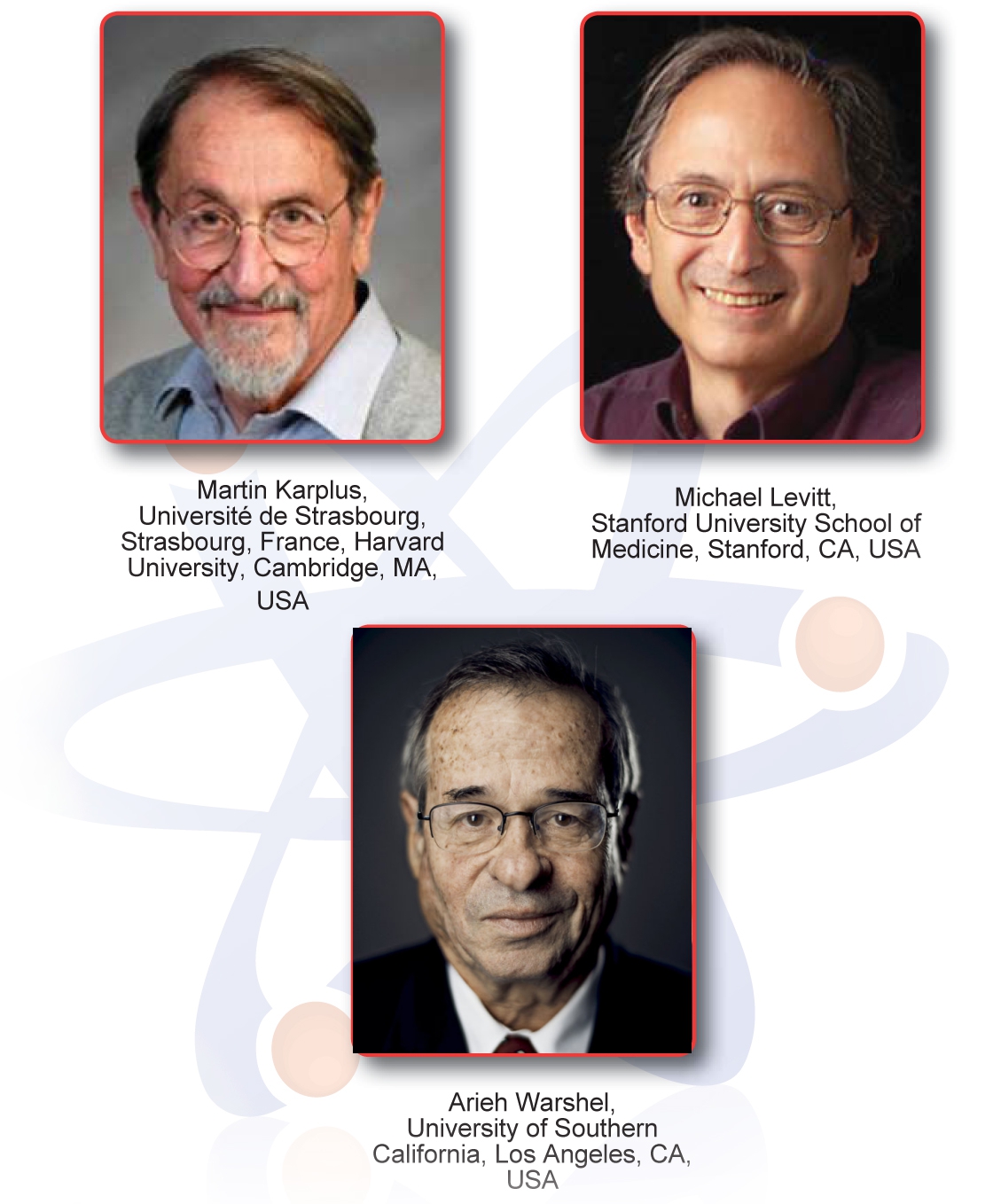| |
NOBEL PRIZE IN CHEMISTRY -
COMPUTATIONAL BIOLOGY AT CENTER STAGE

The 2013 Nobel Prize in Chemistry was awarded to Martin Karplus,
Michael Levitt, and Arieh Warshel for the "development of multiscale
models for complex chemical systems." This award has marked a major
turning point for computational biology through recognition that
computation transforms the way scientists study the structure and
function of biochemical molecules.
The seminal work
attributed to the development of multiscale modeling began in the
1970's when Warshel joined Karplus's lab at Harvard as a
postdoctoral fellow. Warshel had just completed his doctorate in
chemical physics at the Weizmann Institute of Science in Rehovot,
Israel, where he worked under the guidance of Shneior Lifson to
develop methods to calculate consistent force fields of molecules1,2. Lifson, who passed away in 2001, is considered a founding father
of computational structural biology and also mentored Levitt as a
young student. Karplus had expertise in applying quantum mechanics
to chemical reactions. Together they developed a computer program
that used a combination of classical and quantum mechanical
calculations to consistently determine the ground and excited state
potentials of complex molecules3. This was the first time that
classical and quantum mechanics were used together to model complex
molecules, and a similar method was also used to calculate changes
in the conformation of retinal isomers upon photoactivation4,5. This
novel approach was based on partitioning electrons in planar
molecules such that Π-electrons were modeled using quantum chemical
calculations and σ-electrons and nuclei modeled using classical
mechanics.
Warshel returned to Weizmann after his
postdoctoral training and started working with Levitt, who had also
come back to Weizmann after completing a research fellowship at
Cambridge University. Their groundbreaking work involved developing
a universal scheme to partition electrons in a molecule that are
modeled using classical or quantum approaches. This hybrid quantum
mechanics/molecular mechanics approach made it possible to model
chemical reaction and complex molecules like proteins by combining
the accuracy of quantum mechanics and the speed of classical
molecular mechanics . They used this hybrid approach to model how
lysozyme cleaves a glycoside chain. Levitt and Warshel also
developed computational methods to study the folding of bovine
pancreatic trypsin inhibitor by grouping atoms that could be modeled
classically in rigid "pseudoatoms," which greatly enhanced the speed
by which folding could be modeled .
The work of Karplus,
Levitt, and Warshel formed the foundation of molecular modeling and
has been essential to moving forward research in both theoretical
and experimental chemistry and biochemistry. Levitt, a previous
keynote speaker at the 3Dsig satellite meeting of ISMB, as well as
Karplus and Warshel have been honored with lifetime membership in
ISCB in recognition of this achievement.
References
1Lifson S, Warshel A. (1968). A Consistent Force Field
for Calculation on Conformations, Vibrational Spectra and Enthalpies
of Cycloalkanes and n-Alkane Molecules. J. Phys. Chem. 49 (11):
5116.
2Warshel A, Lifson S. (1970). Consistent Force Field
Calculations. II. Crystal Structure, Sublimation Energies, Molecular
and Lattice Vibrations, Molecular Conformations and Enthalpies of
Alkanes. J. Chem. Phys. 53 (2): 582.
3Warshel A, Karplus M.
(1972). Calculation of ground and excited state potential surfaces
of conjugated molecules. I. Formulation and parametrization. J. Am.
Chem. Soc. 94 (16): 5612.
4Rowan R, Warshel A, Sykes BD, and
Karplus M. (1974). Conformation of Retinal Isomers. Biochemistry.
13(5): 970.
5Warshel A, Karplus M. (1974). Calculation of
pi-pi excited state conformations and vibronic structure of retinal
and related molecules. J. Am. Chem. Soc. 96(18):5677.
6Warshel, A; Levitt, M (1976). Theoretical studies of enzymic
reactions: Dielectric, electrostatic and steric stabilization of the
carbonium ion in the reaction of lysozyme. J. Mol. Biol. 103 (2):
227.
7Levitt M, Warshel A. (1975). Computer simulation of
protein folding. Nature. 253: 694.
top |

